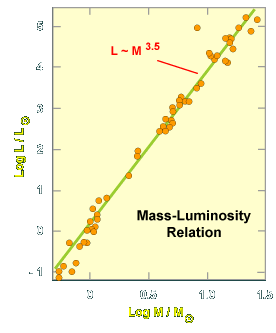Mass-Luminosity Relationship for Main Sequence Stars
Based on years of painstaking observations
of binary star
systems to deduce the masses of stars and distance determinations
to find the luminosities of stars, a
Mass-Luminosity Relationship
for Main Sequence stars has been found:

|
Roughly speaking,
according to the line drawn on the figure.
The left panel differs slightly from more precise statements.
The luminosity goes roughly as M4 for stars more massive than
~ 70 % of the Sun and rougly as M3 for stars less massive than
~70 % of the Sun.
(The latter estimate is roughly that given in the text.)
|
In any event, the luminosity of a star depends strongly on its mass.
Using the Mass-Luminosity relation, we infer that the least
massive stars are at the lower right hand part of the Main Sequence
and that the most massive stars are at the upper left hand part of the
Main Sequence. The Sun, a G2V star sits around the
middle of the Main Sequence.

The fact that the luminosity depends so strongly
on the mass of a star has great implications for how long
stars live on the Main Sequence.
Massive stars have very short lifetimes compared to the Sun (which has a
lifetime on the order or 10 billion years or so),
as we will see later. For example, a star 10 times as massive as the Sun
has a lifetime of only 10 million years. A star 10 % the mass of the Sun
has a lifetime of 1 trillion years, a lifetime greater than the current age
of the Universe!



